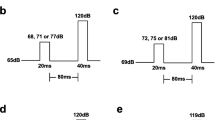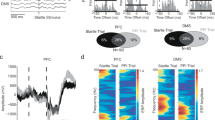Abstract
Rationale
Psychoses are debilitating side effects associated with current dopaminergic treatments for Parkinson's disease (PD). Prepulse inhibition (PPI), in which a non-startling stimulus reduces startle response to a subsequent startle-eliciting stimulus, is important in filtering out extraneous sensory stimuli. PPI deficits induced by dopamine agonists can model symptoms of psychosis. Adenosine A2A receptor antagonists, being developed as novel PD treatments, indirectly modulate dopamine signaling in the basal ganglia and may have an improved psychosis profile which could be detected using the PPI model.
Objectives
The aims of this study is to characterize PPI in MitoPark mice, which exhibit progressive loss of dopamine signaling and develop a Parkinson-like motor phenotype, and assess standard and novel PD treatment effects on PPI in MitoPark mice, which more closely mimic the basal ganglia dopamine status of PD patients.
Results
MitoPark mice displayed enhanced PPI as dopamine tone decreased with age, consistent with studies in intact mice that show enhanced PPI in response to dopamine antagonists. Paradoxically, older MitoParks were more sensitive to PPI disruption when challenged with dopamine agonists such as apomorphine or pramipexole. Alternatively, SCH 412348, an adenosine A2A antagonist, did not disrupt PPI in MitoPark mice at doses that normalized hypoactivity.
Conclusion
Use of MitoPark mice in the PPI assay to assess the potential for PD treatment to produce psychoses likely represents a more disease-relevant model. SCH 412348 does not differentially disrupt PPI as do dopamine agonists, perhaps indicative of an improved psychosis profile of adenosine A2A antagonists, even in PD patients with decreased dopamine tone in the basal ganglia.







Similar content being viewed by others
References
Baker WL, Silver D, White CM, Kluger J et al (2009) Dopamine agonists in the treatment of early Parkinson’s disease: a metal analysis. Parkinsonism Relat Disord 15:287–294
Bleickardt CJ, LaShomb AL, Merkel CE, Hodgson RA (2012) Adenosine A2A receptor antagonists do not disrupt rodent prepulse inhibition: an improved side effect profile in the treatment of Parkinson’s disease. Parkinsons Dis 2012:1–9
Bogaerts V, Theuns J, Van Broeckhoven C (2008) Genetic findings in Parkinson's disease and translation into treatment: a leading role for mitochondria? Genes Brain Behav 7:129–151
Braff DL, Grillon C, Geyer MA (1992) Gating and habituation of the startle reflex in schizophrenic patients. Arch Gen Pyschiatry 49:206–215
Chang WL, Geyer MA, Buell MR, Weber M, Swerdlow NR (2010) The effects of pramipexole on prepulse inhibition and locomotor activity in C57BL/6J mice. Behav Pharmacol 21:135–143
Chang WL, Breier MR, Yang A, Swerdlow NR (2011) Disparate effects of pramipexole on locomotor activity and sensorimotor gating in Sprague–Dawley rats. Pharmacol Biochem Behav 99:634–638
Chen JF, Eltzschig HK, Fredholm BB (2013) Adenosine receptors as drug targets—what are the challenges? Nat Rev Drug Discov 12:265–286
Dauer W, Przedborski S (2003) Parkinson’s disease: mechanisms and models. Neuron 39:889–909
Delwaide PJ, Pepin JL, Maertens de Noordhout A (1990) Startle reaction in parkinsonism: new evidence implying the reticular formation in pathophysiology of motor troubles. Mov Disord 5S:23
Ekstrand MI, Terzioglu M, Galter D, Zhu S, Hofstetter C, Lindqvist E, Thams S, Bergstrand A, Hansson FS, Trifunovic A, Hoffer B, Cullheim S, Mohammed AH, Olson L, Larsson NG (2007) Progressive parkinsonism in mice with respiratory-chain-deficient dopamine neurons. PNAS 104(4):1325–1330
Ekstrand MI, Galter D (2009) The MitoPark Mouse—an animal model of Parkinson's disease with impaired respiratory chain function in dopamine neurons. Parkinsonism Relat Disord 153:5185–5188
Etminan M, Gill S, Samii A (2003) Comparison of the risk of adverse effects with pramipexole and ropinirole in patients with Parkinson’s disease: a meta-analysis. Drug Saf 26(6):439–444
Factor SA, Feustel PJ, Freidman JH et al (2003) Longitudinal outcome of Parkinson’s disease patients with psychosis. Neurology 60:1756–1761
Fenelon G, Mahieux F, Huon R, Ziegler M (2000) Hallucinations in Parkinson's disease. Prevalence, phenomenology and risk factors. Brain 123(4):733–745
Fenelon G, Goetz CG, Karenberg A (2006) Hallucinations in Parkinson disease in the pre-levodopa era. Neurology 66:93–98
Fenelon G (2008) Psychosis in Parkinson’s disease: phenomenology, frequency, risk factors, and current understanding of pathophysiologic mechanisms. CNS Spectr 13(4):18–25
Fenelon G, Alves G (2010) Epidemiology of psychosis in Parkinson’s disease. J Neurol Sci 289:12–17
Ferre S, Fredholm BB, Morelli M, Popoli P, Fuxe K (1997) Adenosine–dopamine receptor–receptor interactions as an integrative mechanism in the basal ganglia. Trends Neurosci 20:482–487
Fernandez H (2012) Nonmotor complications of Parkinson disease. Cleve Clin J Med 79(2):S14–S18
Flood DG, Zuvich E, Marino MJ, Gasior M (2011) Prepulse inhibition of the startle reflex and response to antipsychotic treatments in two outbred strains in comparison to the inbred DBA/2 mice. Psychopharmacology (Berl) 215(3):441–454
Forsaa EB, Larsen JP, Wentzel-Larsen T, Alves G (2010) What predicts mortality in Parkinson’s disease? A prospective population-based long-term study. Neurology 75:1270–1276
Friedman JH (2010) Parkinson’s disease psychosis 2010: a review article. Parkinsonism Relat Disord 16:553–560
Galter D, Pernold K, Yoshitake T, Lindqvist E, Hoffer B, Kehr J, Larson NG, Olson L (2010) MitoPark mice mirror the slow progression of key symptoms and L-DOPA response in Parkinson's disease. Genes Brain Behav 9:173–181
Geyer MA, Krebs-Thomson K, Braff DL, Swerdlow NR (2001) Pharmacological studies of prepulse inhibition models of sensorimotor gating deficits in schizophrenics: a decade in review. Pyschopharmacology 156:117–154
Hickey P, Stacy M (2012) Adenosine A2A antagonists in Parkinson’s disease: what’s next? Curr Neurol Neurosci Rep 12(4):376–385
Hodgson RA, Bedard PJ, Varty GB et al (2010) Preladenant, a selective A(2A) receptor antagonist, is active in primate models of movement disorders. Exp Neurol 225(2):384–390
Hodgson RA, Bertorelli R, Varty GB et al (2009) Characterization of the potent and highly selective A2A receptor antagonists preladenant and SCH 412348 [7-[2-[4-2,4-difluorophenyl]-1-piperazinyl]ethyl]-2-(2-furanyl)-7H-pyrazolo[4,3-e][1,2,4]triazolo[1,5-c]pyrimidin-5-amine] in rodent models of movement disorders and depression. J Pharmacol Exp Ther 330(1):294–303
Hristova AH, Koller WC (2000) Early Parkinson’s disease: what is the best approach to treatment? Drugs Aging 17(3):165–181
Hughes AJ, Bishop S, Kleedorfer B, Turjanski N et al (1993) Subcutaneous apomorphine in Parkinson’s disease: response to chronic administration for up to 5 years. Mov Disord 8(2):165–170, J Neurol Sci 289:12-17
Kaasinen V, Ruottinen HM, Nagren K, Lehikoinen P, Oikonen V, Rinne JO (2000) Upregulation of putaminal dopamine D2 receptors in early Parkinson’s disease: a comparative PET study with [11C]raclopride and [11C]N-methylspiperone. J Nucl Med 41(1):65–70
Marcellino D, Lindqvist E, Schneider M et al (2010) Chronic A2A antagonist treatment alleviates parkinsonian locomotor deficiency in MitoPark mice. Neurobiol Dis 40(2):460–466
Nakashima K, Shimoyama R, Yokoyama Y, Takahashi K (1993) Auditory effects on the electrically elicited blink reflex in patients with Parkinson’s disease. Electroencephalogr Clin Neurophysiol 89:108–112
Newman-Tacredi A, Cussac D, Audinot V, Nicolas JP et al (2002) Differential actions of antiparkinson agents at multiple classes of monaminergic receptor. II. Agonist and antagonist properties at subtypes of dopamine D2-like receptor and α1/α2-adrenoceptor. JPET 303:805–814
Poewe W, Mahlknecht P, Jankovic J (2012) Emerging therapies in Parkinson’s disease. Curr Opin Neurol 25(4):488–459
Rinne JO, Iivanainen M, Metsahonkala L, Vainionpaa L, Paakkonen L, Nagren K, Helenius H (2004) Striatal dopaminergic system in dopa-responsive dystonias: a multi tracer PET study shows increased D2 receptors. J Neurol Transm 111(1):59–67
Salamone JD, Betz AJ, Ishiwari K, Felsted J, Madson L, Mirante B, Clark K, Font L, Korbey S, Sager TN, Hockemeyer J, Muller CE (2008) Tremorolytic effects of adenosine A2A antagonists: implications for parkinsonism. Front Biosci 13:3594–3605
Sanchez-Ramos JR, Ortoll R, Paulson GW (1996) Visual hallucinations associated with Parkinson's disease. Arch Neurol 53(12):1265–1268
Schapira AH (2008) Mitochondria in the aetiology and pathogenesis of Parkinson's disease. Lancet Neurol 7:97–109
Scherfler C, Khan NL, Pavese N et al (2006) Upregulation of dopamine D2 receptors in dopaminergic drug-naïve patients with Parkin gene mutations. Mov Disord 21:783–788
Schicatano EJ, Peshori KR, Gopalaswamy R, Sahay E, Evinger C (2000) Reflex excitability regulates prepulse inhibition. J Neurosci 20(11):4240–4247
Schwarzchild MA, Agnati L, Fuxe K, Chen JF, Morelli M (2006) Targeting adenosine A2A receptors in Parkinson’s disease. Trends Neurosci 29:647–654
Seeman P (1987) Dopamine receptors and the dopamine hypothesis of schizophrenia. Synapse 1(2):133–152
Silvestri S, Seeman MV, Negrete JC, Houle S et al (2000) Increased dopamine D2 receptor binding after long-term treatment with antipsychotics in humans: a clinical PET study. Psychopharmacology 152:174–180
Singer P, Wei CJ, Chen JF, Boison D, Yee BK (2013) Deletion of striatal adenosine A2A receptor spares latent inhibition and prepulse inhibition but impairs active avoidance learning. Behav Brain Res 242:54–61
Swerdlow NR, Mansbach RS, Geyer MA, Pulvirenti L, Koob GF, Braff DL (1990) Amphetamine disruption of prepulse inhibition of acoustic startle is reversed by depletion of mesolimbic dopamine. Psychopharmacology 100:413–416
Swerdlow NR, Braff DL, Taaid N, Geyer MA (1994) Assessing the validity of an animal model of deficient sensorimotor gating in schizophrenic patients. Arch Gen Psychiatry 51:139–154
Swerdlow NR, Geyer MA (1998) Using an animal model of deficient sensorimotor gating to study the pathophysiology and new treatments for schizophrenia. Schizophr Bull 24:285–301
Swerdlow NR, Light GA, Cadenhead KS, Sprock J, Hsieh MH, Braff DL (2006) Startle gating deficits in a large cohort of patients with schizophrenia: relationship to medications, symptoms, neurocognition, and level of function. Arch Gen Psych 63(12):1325–1335
Thanvi BR, Lo TCN, Harsh DP (2005) Psychosis in Parkinson’s disease. Postgrad Med J 81:644–646
Valls-Sole J, Munoz JE, Valldeoriola F (2004) Abnormalities of prepulse inhibition do depend on blink reflex excitability: a study in Parkinson’s disease and Huntington’s disease. Clin Neurophysiol 115:1527–1536
Williams DR, Lees AJ (2005) Visual hallucinations in the diagnosis of idiopathic Parkinson disease: a retrospective autopsy study. Lancet Neurol 4:605–610
Acknowledgment
The authors would like to thank Charles Joseph for the pharmacokinetic analysis of plasma and brain exposures of pramipexole and SCH 412348 in MitoPark mice and age-matched controls.
Disclosure
SMG, RH, and LAH are responsible for the work described in this paper. All authors were involved in at least one of the following: conception, design, acquisition, analysis, statistical analysis, and interpretation of data; and drafting the manuscript and/or revising the manuscript for important intellectual content. All authors provided final approval of the version to be published.
Conflict of interest
SMG, RH, and LAH are employees of Merck Sharp & Dohme Corp., a subsidiary of Merck & Co., Inc., who may own stock and/or hold stock options in the Company.
Author information
Authors and Affiliations
Corresponding author
Electronic supplementary material
Below is the link to the electronic supplementary material.
ESM 1
(DOC 217 kb)
Rights and permissions
About this article
Cite this article
Grauer, S.M., Hodgson, R. & Hyde, L.A. MitoPark mice, an animal model of Parkinson’s disease, show enhanced prepulse inhibition of acoustic startle and no loss of gating in response to the adenosine A2A antagonist SCH 412348. Psychopharmacology 231, 1325–1337 (2014). https://doi.org/10.1007/s00213-013-3320-5
Received:
Accepted:
Published:
Issue Date:
DOI: https://doi.org/10.1007/s00213-013-3320-5




